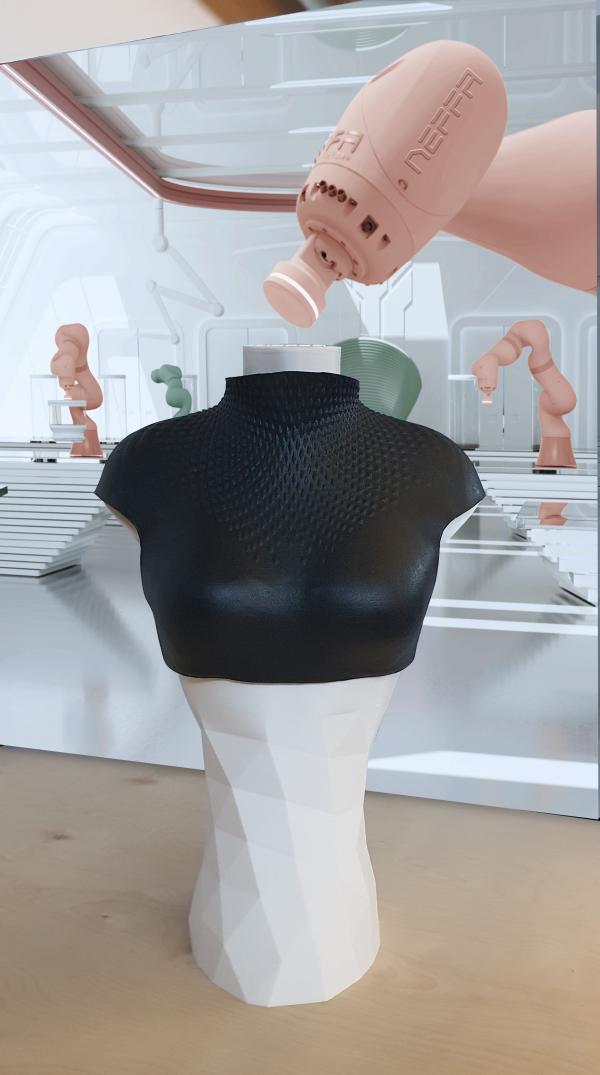A Dutch company offers an all-in-one solution for fashion brands using automation to create mushroom-based materials and reduce fashion waste
If Aniela Hoitink has her way, fungi is the future of fashion.
After majoring in fashion design and working for years for fashion brands, Aniela decided to strike out on her own and create something new.
In 2014, she answered an open call from a professor at Utrecht University looking to collaborate with artists and designers to create products with mycelium, the thread-like root system of mushrooms. “He told me about the benefits it could have,” recalls Aniela. “That got me really excited, because it meant we could finally make biodegradable garments.”
Mycelium was already being grown for other products like laundry detergent made with its enzymes, but Aniela says she was the first to see its potential as a replacement for leather and plastic in clothes, footwear, and accessories. Working with Professor Han Wösten, she had proof of concept within two years, unveiling a dress made from her “mushroom leather,” which she named MYCOTEX.
3D technology and automated manufacturing for clothes
Aniela also developed a 3D manufacturing method for MYCOTEX, called NEFFA, which stands for New Fashion Factory. Despite the name, NEFFA doesn’t have its own factory but works hand in hand with two European partners.
One grows the biomass on demand, cultivating it in large fermenters in a kind of soup made of water, sugars, and minerals. “In five to seven days we have a huge pile of mycelium, and that’s our base material,” Aniela says. This is mixed with other natural ingredients, or what she calls her “secret sauce,” to make MYCOTEX.
NEFFA’s other partner is the German production facility DESMA, which supplies clients with local manufacturing systems. Robots apply MYCOTEX onto 3D moulds to create seamless garments thatare ready as soon as the fabric dries.

MYCOTEX uses 3D moulds to create seamless garments
The technology gives brands immense freedom to design different shapes, colours, patterns, logos, and textures. They can select different fabric thicknesses, or degrees of flexibility, from firm to malleable.
In the future, NEFFA will allow consumers to scan their bodies using a smartphone, upload the image, and order a garment that is made to measure. “The holy grail in fashion is personalisation on a mass production level,” Aniela says.
In 2022, MYCOTEX by NEFFA was a finalist in the European Investment Bank Institute’s Social Innovation Tournament, which recognises entrepreneurs that are making a positive impact socially, ethically, or environmentally.
Zero production waste and 100% biodegradable
More than just a futuristic fabric, MYCOTEX by NEFFA represents a whole new supply chain that seeks to solve some of the major issues in fashion, including raw material consumption, hazardous chemicals, unsavoury labour practices, and enormous waste.
There are three types of waste in the industry, says Aniela, starting with pre-consumer waste from overproduction. “You produce 1 000 pieces even though you only need 900, because 1 000 makes the product cheaper.”
Production waste accounts for 10-30% of textiles ending up on the cutting room floor. And when consumers throw their clothing away, about 87% is incinerated or goes to landfill.
With MYCOTEX by NEFFA, there is no need for farmland, chemicals, or low-paid labour in faraway countries. In 2021, Accenture performed an impact potential study and found that this solution could save the equivalent of 430 000 jackets per year by 2030.
MYCOTEX uses a circular supply chain where at the end of a garment’s life, a consumer can simply toss it into the compost bin since the material is biodegradable. Even so, the material still meets all fashion industry standards for strength and tear resistance, so there is no risk of a dress falling apart at a dinner party.
To have the MYCOTEX name on the label, brands pay a fee to use the fabric and system. “We think this is an added benefit for them, and consumers who recognise the seamless garments will know that they are sustainably produced,” Aniela says.
Manufacturers who want to work with the supply chain technology pay a licencing fee and buy the equipment and biomass from the company’s partners. It takes only about a week to set up a factory.
Currently, MYCOTEX by NEFFA is developing prototypes for a handful of brands. The company has just launched its first funding round, to increase its impact by doubling its team and moving from pilot to demo scale. If all goes well, the first products should hit the market by late 2023 or early 2024.
The company is starting with the luxury sector, since innovation tends to be expensive at the start. By 2028, Aniela plans to expand to fast fashion, thanks to economies of scale. After that, she hopes to tackle other textile markets, such as interiors and automotive, and even to work with other innovative fabrics.
“The goal that we have set is to become a new manufacturing method next to cutting, sewing, and knitting,” Aniela says.
In other words, she is reinventing the spinning wheel.
